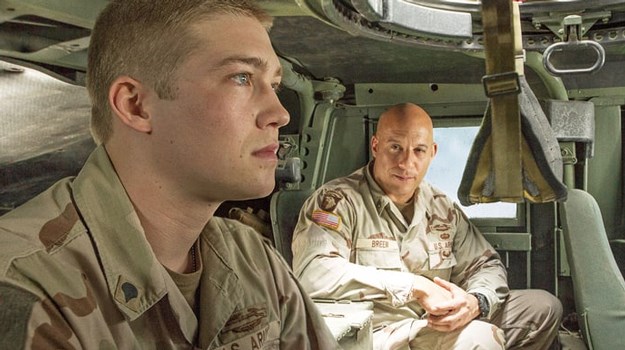During a time where American patriotism is rebooted and the mighty dollar rules, and the War in Iraq has become a stale memory, Billy Lynn’s Long Halftime Walk is a socially relevant film that shows how revered heroes – on the sports field, in the music world, as cheer leaders, or in battle during war – become adulated puppets on a string.

When Billy Lynn receives a medal for bravery for saving his platoon leader and instinctively killing the enemy during a one-on-one skirmish in Iraq, the medal blinds those who worship him, and frightens the people in his life, who become outsiders to him.
Lee brilliantly contrasts four different points of view during Lynn’s walk to fame during a Victory Tour, a young man who is passionate about being a soldier and being ‘loved’ for who he is and what he is willing to do to save his fellow Bravo Squad brothers; a soldier who fails to understand the blind worship and gets caught up in the glory of fabricated fame and becoming a trophy; a brother and a son who becomes an outsider to his family; and a young man who falls in love with another trophy (a cheerleader played by Makenzie Leigh).
These different viewpoints inject the narrative with tension and skilfully draw us into an intimate connection with the character and how he relates to the different situations.

The film reminds one strongly of Milos Forman’s Hair, who equally ridiculed the essence of war and the fate of young men destined to serve for glory, and Stanley Kubrick’s Full Metal Jacket, where the soldier almost becomes a clown trapped in a war of horror.
Lee’s visual sensibility astounds. After working on Life of Pi (2012), Lee wanted to up his use of technology in filmmaking, especially in terms of frame rate, since he thought pursuing a higher frame would help him find answers. For Billy Lynn’s Long Halftime Walk, Lee used an unprecedented shooting and projection frame rate of 120 frames per second in 3D at 4K HD resolution, which Lee terms the "whole shebang".
It’s marked as the first feature film ever to be shot in such a high frame rate, over twice the previous record (Peter Jackson's 2012 The Hobbit: An Unexpected Journey, shot at 48 fps) and five times the standard speed of 24 fps.
Lee undertook such a bold step after reading Ben Fountain’s novel, since he wanted the film to be an "immersive" and "realistic" experience of the reality and emotional journey of soldiers.

British actor Joe Alwyn shines radiantly as Billy Lynn, brilliantly capturing the heartache, fear and elation of a young man who becomes of age during his valour.
The reality and fantasy of war clash head on in the film during the super spectacular halftime show of the Thanksgiving Day football game, where the glory of being a war hero outshines the reality of what really happened to the squad.
A bloodstained military uniform tarnished during battle becomes a costume during a grotesque live stage broadcast to millions of TV viewers, where soldiers are forced to entertain, just as they are trained to follow the harsh rules of war.
War has become mass entertainment in a zillion dollar industry, a frivolous amusement to quench the thirst of bloodthirsty worshippers who have become bored with their video games.
Billy Lynn’s Long Halftime Walk shows that war is definitely not an entertaining and amusing spectacle, and that the tragedy and horror that befalls its victims can never compete with the fantasy of war ruthlessly staged by oblivious worshippers.
If there’s one scene you will always remember from Billy Lynn’s Long Halftime Walk, it’s the touching ending, where Billy Lynn bravely confronts the motive that inspires heroism and redeems his fear.
Read more about the latest film releases: www.writingstudio.co.za
